Menu

Livestock makes up 40% of the world’s agricultural wealth and supports about 1.3 billion people. This shows how important it is in the global food system and for people’s jobs and food. It’s crucial for farming and food reliability.
Sustainable livestock farming is crucial for our planet. It keeps the land diverse and helps fight climate change by capturing carbon. It’s especially needed in places like mountains and dry areas. Even though it’s growing in places with less money, it faces many challenges. These include making sure it’s sustainable, fair, and healthy for the planet and our health. Following goals for sustainable development is essential for the livestock sector to keep growing well.
More people are asking for livestock products as the world’s middle class grows and the population is set to reach 10 billion by 2050. This makes the move to sustainable ways very urgent.
Sustainable livestock farming helps us balance food needs with environmental protection. It focuses on eco-friendly ways, keeps animals and humans healthy, and supports farmers. This way, we can meet our food needs without harming the planet.
It’s about using resources wisely to look after our world. This type of farming includes smart breeding, using renewable energy, and keeping our land diverse. These methods boost how much food we make without hurting nature.
Livestock is key, providing 40% of our food and helping 1.3 billion people. Sustainable farming fights climate change by cutting emissions and storing carbon. It also makes sure animals are well taken care of, helping farms survive and the planet thrive.
It’s clear that livestock does more than feed us; it helps grow our crops and is a big income source. Sustainable ways mean we can enjoy these benefits without hurting the future.
Livestock farming plays a big part in greenhouse gas emissions, causing concern for the environment. It’s crucial to look closely at the carbon footprint and water use in this industry. We need smart strategies to combat its effects.
About 14.5% of greenhouse gases come from the livestock sector each year. This amounts to roughly 7.1 GT of CO2 annually. As more people worldwide eat meat and dairy, it’s vital to lower these emissions.
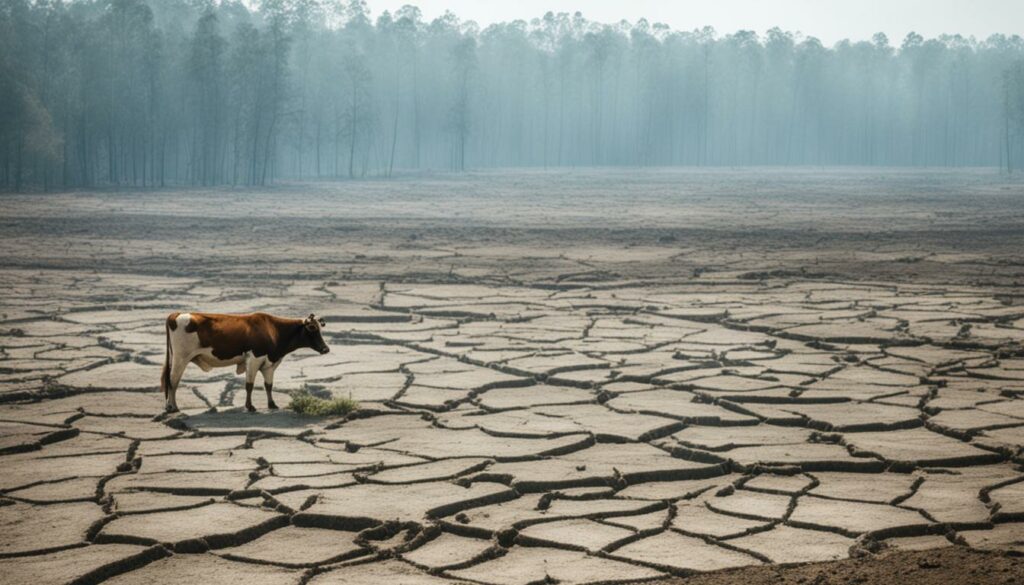
The World Bank is leading in funding projects that lessen climate impact in livestock. In Argentina, for example, investing in better pastures fights desertification and climate change. In Colombia, changing degraded lands boosted milk and cut carbon.
The farms use a lot of water, with animal agriculture using about 55% in the US. This high water use demands sustainable methods to avoid water shortage and pollution.
The Sahel project shows how managing pastures can help many, including women. Mexico set an example by adopting green energy, reducing a large amount of CO2. Both cases point towards effective solutions.
To make a real change, livestock farming needs holistic efforts. This involves using resources better, supporting sustainable methods, and making policies that protect our environment. These steps aim to benefit everyone, animals and humans alike.
Looking after animals well is key in sustainable farming. Studies worldwide show more people want animals to live naturally. People are very worried about how farm animals are treated.
Keeping animals for food harms the planet a lot, causing global warming and using lots of water. This means we need to farm in ways that do less harm. Many people say caring for animals is more important than other farm issues or low prices.
They care a lot about the animals being happy. This shows how important it is to treat animals well in farming today.
Taking the best care of animals is good for business and the planet. It means fewer animals get sick and die. This helps to cut down on bad gases that harm the Earth.
So, focusing on animal health helps the animals, the farm, and our planet.
Being kind to animals is a must for farming to last. This means making sure they never go hungry, get hurt, or feel afraid. Farming this way not only helps animals but also makes farms more successful. A study in Germany found people really care about this, even more than costs.
Here is what people usually prefer when it comes to farming animals:
| Criteria | Consumer Preference |
|---|---|
| Animal Welfare | High |
| Environmental Efficiency | Medium |
| Economic Efficiency | Low |
It’s very clear that good care for animals is extremely important. It’s both an ethical issue and good for business. People know that better animal care can lead to more and better food without harming the planet.
Nowadays, organic and ethical sourcing in livestock farming is key to sustainable agriculture. More people want livestock products made responsibly. This is because they care about the environment and want to support ethical farming.
Organic farming has strict rules. These include looking after the animals well, using good feed, and avoiding chemicals. These standards protect the health of animals and the Earth.
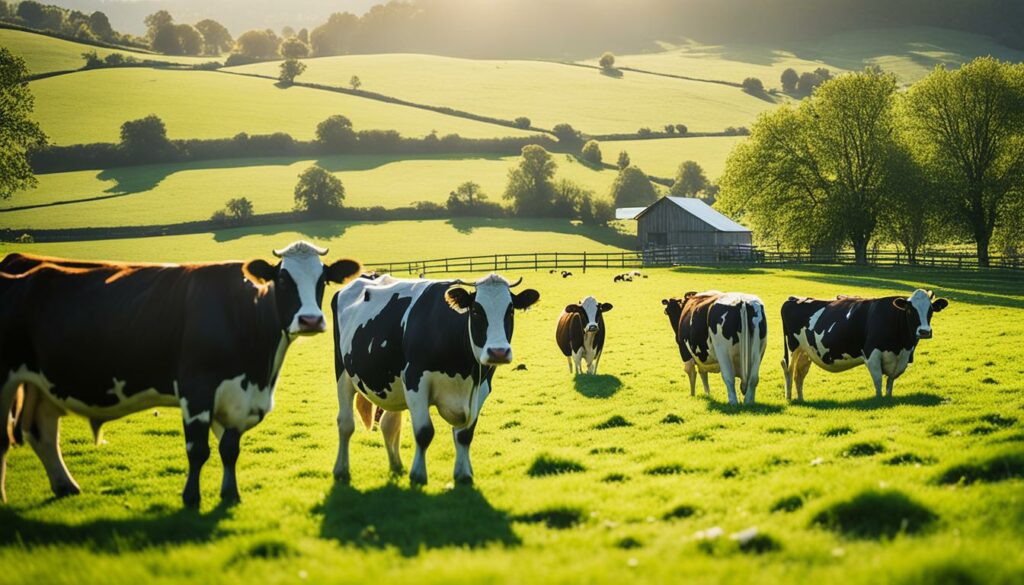
Organic livestock farming is all about top care for animals. It uses natural feeds, not chemicals. This way of farming looks after the whole environment around the farm, not just the animals.
Around 500 million farmers around the world follow these organic ways. By caring for the animals and the land, these farmers play a big part in protecting our planet.
Ethical sourcing looks at the whole journey our food takes, from farm to table. It cares about how food is grown and picked. This helps make sure the food is good for us and good for the planet.
In Mexico, for example, a project in 2016 helped over 1,000 businesses become more eco-friendly. They cut down on harmful emissions a lot. This shows how powerful ethical sourcing can be in making our food better in many ways.
| Key Benefits | Details |
|---|---|
| Improved Public Perceptions | Standard certifications like Fair Trade and USDA Organic ensure consumer confidence. |
| Healthier Food Products | Organic and ethically sourced meat, dairy, and eggs have favourable nutritional profiles compared to conventional products. |
| Reduced Environmental Impact | Adoption of environmentally sustainable technologies helps mitigate the livestock sector’s carbon footprint. |
To sum up, combining organic farming with ethical sourcing makes for better livestock farming. It protects both animals and the people who depend on them. This way, we work towards making food and the environment better for everyone.
Exploring the benefits of grass-fed meat and pasture-raised livestock shows many pluses. It’s good for us and the planet. These methods tackle issues in farming today in a big way.
Animals that eat grass directly from pastures provide grass-fed meat. This is instead of eating grains. Grazing on grass boosts their health, giving us more omega-3 and better nutrients than animals fed with grain. This all supports the health and welfare of the animals.
Pasture-raised farming benefits the environment, animal welfare, and us. It lets soils take in and keep carbon, which helps fight climate change. Pigs raised in pastures also help with the variety of plants and keep the soil healthy without chemicals.
Food-wise, chicken eggs and meat from pastures have more vitamins and omega-3. Pork does too. This means their products are higher-quality.
| Livestock | Benefits |
|---|---|
| Pasture-Raised Pigs | Increase plant diversity and improve nutrient cycling. |
| Pastured Chicken | Enhance soil quality and contribute to pest control. |
| Grass-Fed Cattle | Higher omega-3 content and improved nutritional value. |
Practising better grazing also helps soil, water, and more carbon is kept. The Strauss family and others are showing how good this can be. They help save natural areas and wildlife by farming this way.
This way of farming is better for animals too. They are less stressed and healthier. The quality of their life and what they give us is so much better. This is why the higher cost of this meat is worth it.
In short, choosing grass-fed and pasture-raised food is good for everyone. It gives us better food, helps the environment by storing carbon, and supports animal welfare.
Regenerative agriculture in livestock farming combines old and new ways to restore natural systems. It aims for ecosystem health. This method not only helps the beef industry be sustainable. It also improves how we manage grazing and uses green energy.
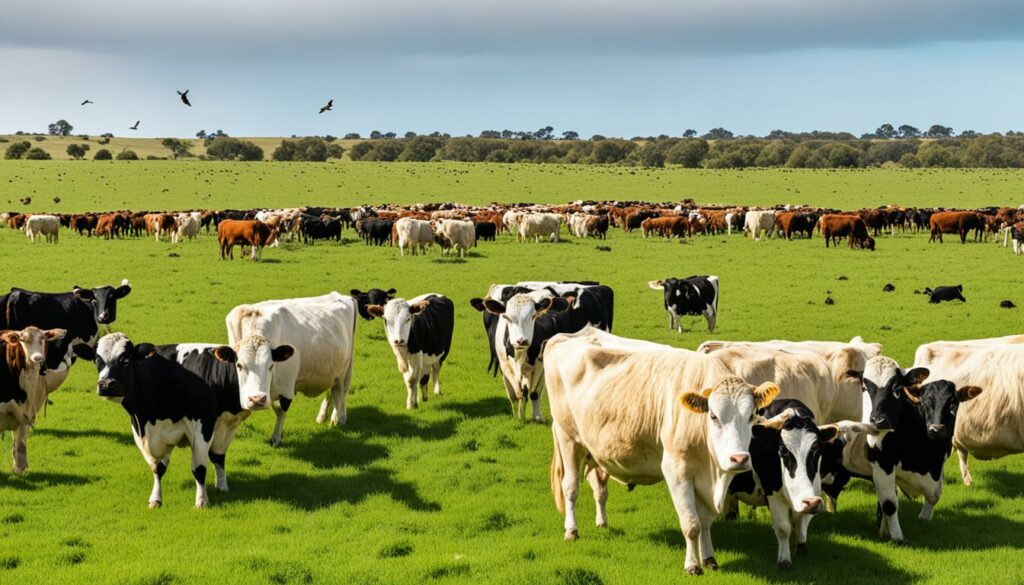
Aldo Leopold’s wisdom guides regenerative agriculture. He spoke of the essentials: the axe, the cow, the plow, the gun, and the match. The focus is on grazing practices that echo what nature intended. This shift helps land recover its health by increasing biodiversity and enriching the soil.
To bring regenerative practices to livestock farms, we blend natural patterns with modern methods. The aim is to boost profits and health of the land. Good cattle care, like choosing the right genes and managing pastures well, is vital. Bringing in animal rotations and planting trees improves the land and protects it from harm. Using clean energy and efficient machines also plays a big part in the process.
We aim to balance the well-being of livestock with the health of grass and the soil. This helps ensure ecosystems stay strong for the long haul. Livestock farms following these methods need less chemical help. This is good news for the environment.
“Combining ecological synergy with advanced techniques is the essence of regenerative agriculture, striking a balance between profitability and ecosystem health.” — Professor Giuseppe Pulina
The livestock sector makes up 40% of the world’s agricultural output. It supports the lives of almost 1.3 billion people. Yet, it also contributes a lot to climate change through its annual CO2 emissions of 7.1 GT. This is 14.5% of all the greenhouse gases we add to the atmosphere every year. So, coming up with new ways to farm is very important.
Tackling the emissions from livestock is key in fighting climate change. It’s important to watch where these emissions are coming from. This way, we can find better ways to reduce them. For example, in Argentina, some farmers have improved the land to fight the spread of deserts. Their methods are good for the environment. In Mexico, using cleaner energy in farming has cut over 3.3 million tons of CO2. Both these cases show that with the right methods, we can tackle emissions effectively.
Another way to help is by farming in a way that captures more carbon. In Uruguay, smarter farming has made beef and dairy farming cleaner. These methods are not only cleaner, they are also more efficient. In Colombia, turning unused land into a mix of trees and livestock has captured over 1 million tons of CO2. This approach not only reduces emissions but also saves our forests and wildlife for the future.
Making these methods normal in more places can make a big difference. From Africa’s Sahel to Mexico, using resources wisely is essential. It not only helps our planet but also ensures there’s enough food for everyone. Embracing cleaner technologies and keeping an eye on emissions are vital parts of a bigger plan to fight climate change in farming.
| Location | Initiative | Impact |
|---|---|---|
| Argentina | Switching to improved natural pasture | Combats desertification and adapts to climate change |
| Mexico | Environmentally sustainable technologies | Reduces CO2 emissions by 3,388,670 tons |
| Uruguay | Climate-smart livestock practices | Improves carbon sequestration and energy efficiency |
| Colombia | Silvopastoral systems | Captures 1.05 million tons of CO2 equivalent and conserves biodiversity |
Putting innovative tech in the livestock area is set to change farming as we know it. IoT sensors and AI tech help farmers watch their animals in new ways. These tools can track the health, food, and the environment the animals live in. They make farming more efficient and improve how well animals are looked after.
IoT tools collect data right away, which can show how much milk an animal makes or its health. For instance, Cainthus uses cameras to check on animals. This isn’t all. AI also makes choices on its own. This helps manage the animals better, making things run smoother and in a way that’s better for the earth.
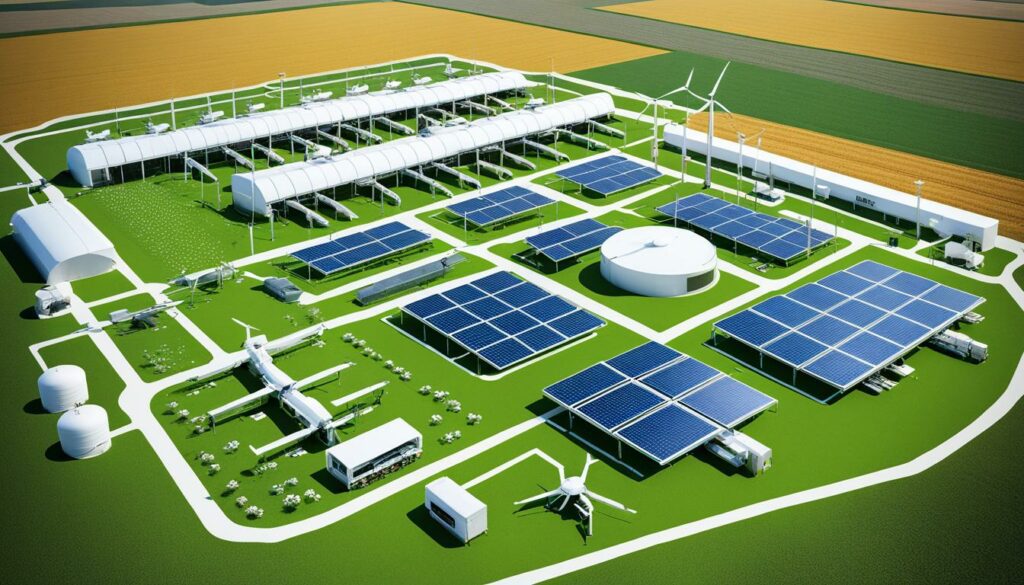
Robot use is growing on farms, maybe soon one in every five will use them. The livestock industry in the United States is really big, worth over $30 billion a year. This shows how tech can really make a difference. But, using tech can be hard because of how farm incomes change, so it has to make sense without costing too much.
Drones are changing how we look after fields and grass. They can check how good the grass is and help keep the land full of different plants and bugs. This is good for the environment and for making sure the animals eat well. Companies like CattleEye use AI to understand the images drones take. They find out lots of useful info. This is all about making farming kinder to our planet.
Firms working on animal research, like Rex Animal Health, are aiming to improve health care for animals. They want to use data to make the life of cows better and make farming more productive. But to really see big changes, using all this data smartly and making decisions together is key.
Livestock farms worldwide are aiming for sustainability. One key step is to improve how animals are fed. This doesn’t just make things more efficient. It also helps to lower methane and keeps the environment healthy.
Every animal needs a unique diet. This is where precision feeding comes in. It tailors the food animals get to exactly what they need. Doing this makes sure they stay healthy and productive. This is very important for a sustainable future in farming.
Using leftovers from farming, like sugar beet molasses, is vital for better feeding management. It helps cut down on using a lot of energy for feed. Plus, it’s good for dealing with waste and making sure animals get the food they need. This smart feeding also helps reduce costs and pollution from farms.
| Country | Projects and Initiatives | Investment in Climate Co-benefits (Million USD) | CO2 Reduction (Tons) | Beneficiaries |
|---|---|---|---|---|
| Ethiopia | Climate Co-benefit Projects | 108.8 | – | – |
| Bangladesh | Sustainable Livestock Projects | 259 | – | – |
| Mexico | Sustainable Energy Technologies | – | 3,388,670 | 1,165 Small and Medium Agribusinesses |
| Vietnam | Bank-supported Livestock Farmers | – | – | 151,000 Farmers |
| Colombia | Silvopastoral Systems | – | 1.05 Million | 32,000 Hectares of Degraded Land |
Livestock greatly impacts greenhouse gas emissions. It produces 7.1 gigatons of CO2 each year, making up 14.5% of human-caused GHG emissions. Genetic selection in breeding is key to lower these numbers. By choosing animals that produce less methane, farming can cut its carbon footprint.
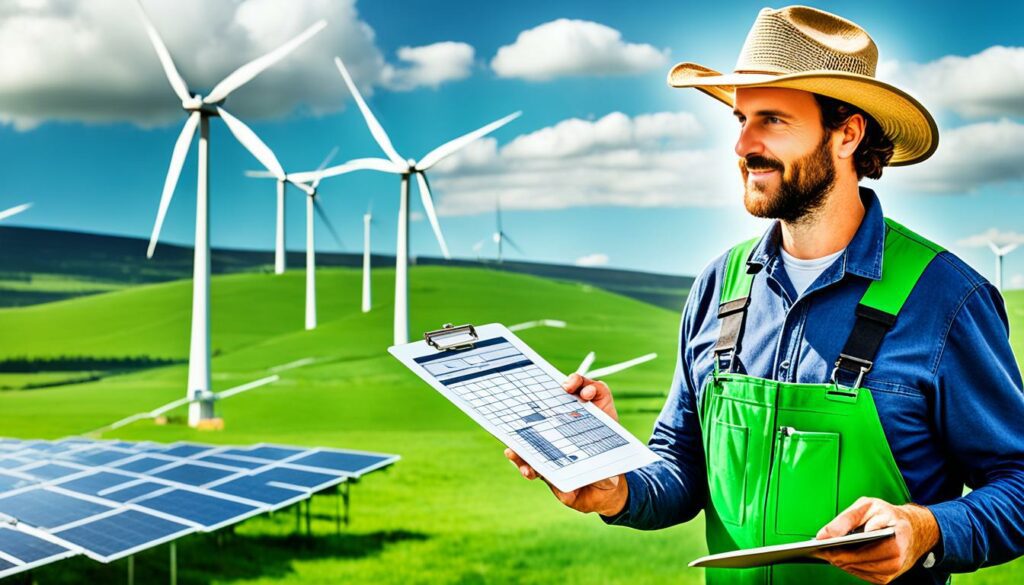
Choosing specific animals to breed is crucial for a greener livestock industry. About 20% of a cow’s methane comes from its genes. So, breeding animals that emit less methane helps a lot. This approach not only lowers emissions but also makes the livestock more efficient and productive.
Using genetic methods, we can find and promote animals that produce less methane. With advanced research, we can pick animals known for their low greenhouse gas emissions. These efforts help the farming industry cut down its carbon output. Also, using digital and automated processes in breeding saves money, reduces mistakes, and speeds up improvements, helping both the economy and the environment.
Here are some statistics about greenhouse gases and the role of genetics:
| Aspect | Percentage/Amount |
|---|---|
| Global livestock GHG contribution | 7.1 GT CO2 equivalent per year |
| Percentage of human-caused GHG emissions | 14.5% |
| Genetic contribution to ruminant methane emissions | 20% |
| Potential methane reduction through breeding | 10-15% |
| GHG emissions from cattle and dairy cows compared to countries | Exceeds any single country other than China |
In summary, breeding management and choosing animals wisely are crucial for a greener livestock industry. By focusing on breeding animals that emit less methane, we take big steps towards a planet-friendly farming sector.
Making sure animals are healthy is key for farms to do well and for the planet. The livestock industry is worth a huge USD$1.36 trillion every year. But it loses about 20% of that because of sickness in animals.
Vet services keep animals well, which helps cut down on bad gases. For example, Foot and Mouth Disease causes losses of $21 billion each year. By using things like vaccines, we can lower these big costs and help farms be more efficient.
Watching animal health closely and stopping sickness is vital for the planet. In places like Argentina, tackling diseases has cut down on harmful emissions by as much as 60%. This shows how important vets are for both health and the environment.
Focusing on keeping animals healthy also makes farms work better. It leads to less pollution. The FAO says taking good care of animals is a must for a healthy planet.
| Country | Annual Economic Loss from Diseases | Emissions Reduction |
|---|---|---|
| USA | PRRS: $664 million | Up to 30% |
| India | Brucellosis: $3.4 billion | Varied |
| Argentina | Trichomoniasis Control | 19-60% |
| Tanzania | East Coast Fever | 29-59% |
Investing in animal health helps the economy and the environment. Healthy animals are more productive and cause less harm to our world. Vets are crucial for today’s farms and nature.
Looking at *sustainable livestock case studies* worldwide teaches us a lot. For example, Argentina, Ethiopia, and Bangladesh show big progress through *global sustainable livestock initiatives*. These studies give ideas that can work in many places and for various people.
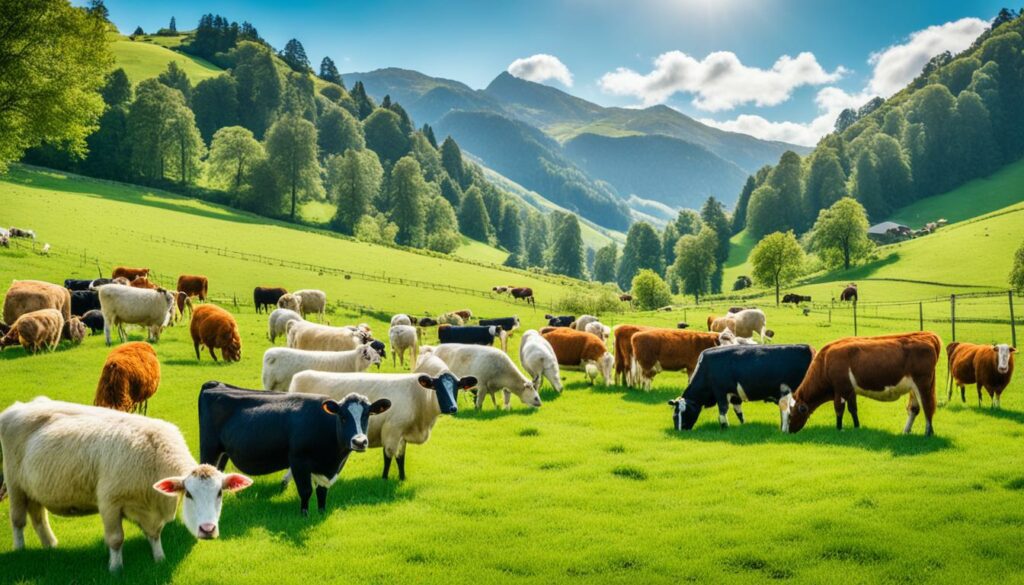
In Argentina, they are moving from cereal to pasture-based farms. This helps the climate a lot. By making these changes, they are following a World Bank goal. This goal aims to spend 61% of money on livestock in ways that help the climate.
In Ethiopia and Bangladesh, there are big projects to deal with climate change. These projects know how important livestock is for people and their food. They aim to help nearly 1.3 billion people around the world.
Countries like Mexico, Uruguay, Vietnam, and Colombia are doing great things too. They show us why working together and using new technology matters. For example, in Mexico, using bio-digesters cut lots of CO2 in 2016. This was over 3 million tons.
Uruguay is also doing its bit by investing in protecting the air and using energy well. This has made farming in Uruguay more sustainable. Vietnam is another place where farmers are seeing the benefits. Over 151,000 farmers there are doing better thanks to new ways of looking after livestock and new farms.
Colombia has its own cool way of farming called silvopastoral systems. It not only helps the planet by capturing CO2, but it also makes more milk and is cheaper. In Kazakhstan, they are focusing on making more beef but in a way that uses less energy. All these stories show how *global sustainable livestock initiatives* are changing agriculture for the better everywhere.
| Country | Key Practice | Outcome |
|---|---|---|
| Argentina | Transitioning to pasture-based grazing | Better resource management |
| Mexico | Use of bio-digesters | Reduced CO2 emissions by 3 million tons |
| Uruguay | Carbon sequestration investments | Improved sustainability |
| Vietnam | Enhanced animal husbandry practices | Improved environmental impact |
| Colombia | Silvopastoral systems | Captured 1.05 million tons of CO2, increased milk production by 17% |
Governments worldwide are key in pushing for sustainable livestock farming. They aim to make sure we have enough food, support people’s lives, and protect our land. Livestock farming policies are very important for this.
When it comes to sustainable livestock, governments provide huge support. They work with the FAO to manage the land well, especially the land that communities use for their animals. Strong laws and organisations are needed to look after the grasslands and rangelands properly.
Governments also look to the UN’s 2030 plan for how they should support sustainable development in farming. The Koronivia Joint Work on Agriculture points out the importance of money and investment. It’s crucial for the field’s growth.
Setting high international standards helps everyone aim for the best. Global regulations encourage a team effort in sustainable farming. The FAO and other big groups push for farming that is good for everyone and the environment.
It’s vital to use livestock to meet our Sustainable Development Goals (SDGs). We need to be smart about including climate change in these plans. Setting up policies based on good information helps keep farming sustainable.
Talking between countries and different groups helps us move towards better farming. The FAO helps by studying and suggesting new ways to farm. These help countries do farming that is better for our planet and the animals.
Sustainable livestock farming is key in meeting global protein needs and caring for our planet. It causes 7.1 gigatons of CO2 each year, 14.5% of all man-made greenhouse gases.
Ruminants, like cows, make a lot of methane because of how their stomachs work. Their genes play a big role in this. Since livestock creates a quarter of the world’s greenhouse gases, we must find new ways to farm.
Using smart technology in farming can make a big difference. Machines for milking, shearing, and feeding are examples. They make farms more efficient, cheaper, and kinder to our planet.
The future of farming is in going digital and using robots more. This way, we can reduce the hard work of farmers and share important data better. As people care more about the planet, farming must follow sustainable and caring ways. This can happen with teamwork between farmers, experts, and the government. They can lead us to a farming future that’s good for Earth and future generations.
Sustainable livestock farming means it’s about finding the right balance. This balance is between needing enough food for people and looking after our planet. It also cares about the well-being of animals and ensuring farms can keep going strong.
Being sustainable in livestock farming is key for a few important reasons. It keeps our food system going strong, helps the environment, and looks out for both human and animal health. It also helps fight off problems that may come from how we produce food.
Livestock farming creates about 14.5% of the greenhouse gas emissions we make. Picture this as 7.1 gigatonnes of CO2 every year. It’s a big challenge that needs smart solutions to lessen its bad impact on our planet.
Farms need a lot of water for several things, like making sure animals have enough to drink, growing food for them, and keeping things clean. They must use water wisely to keep the environment and the animals healthy.
Good farming means looking after animals well. This includes fighting off diseases, giving them the right food, and keeping their homes clean. Doing this also helps farms do better financially and lowers the amount of harmful gases they produce.
Taking care of animals in the right way means giving them enough space, the right food, and any medical help they need. It also means not doing things that scare or hurt them. This is what most people agree is the right thing to do and makes life good for the animals.
Organic livestock farming sticks to strict rules. These rules cover how animals should be treated, what they eat, and using only natural ways to look after them. This makes farming kinder to the earth and the animals.
Getting food in a way that’s good for the planet and the people who work hard to grow it is what ethical sourcing is about. This way, the public likes the food more, it’s healthier, and it’s not so bad for nature.
Grass-fed meat means the animals eat from fields, not grains. This way treats animals better and helps the planet. It makes the land store more carbon and doesn’t use up lots of energy-growing food.
Animals that graze freely, not in cages, are happier and healthier. Their meat or eggs are also better. Plus, the land becomes more alive and the soil healthier.
Regenerative farming is about making the land stronger and helping nature thrive. This is by moving animals around, planting more trees, and using clean energy. It all helps to protect the planet.
To farm in a regenerative way, farmers can move animals to new spots, mix crops with animals, and use clean power. These ways keep the earth and the animals in balance, making farming better for everyone.
Farms can lower the gases they make by using better ways to feed and care for animals. Also, using smart farming technology helps. This means the farm doesn’t harm the planet as much.
To store more carbon, farmers can take better care of the land and plant more trees. Doing these things helps the earth by removing harmful gases from the air.
High-tech tools like IoT and AI help to watch over animals and the farm more closely. They make farming smarter and help to reach goals for the future.
Using drones, farmers can keep an eye on the land and how healthy it is from the sky. Drones help farmers to look after the earth in a way that’s good for everyone.
Giving animals just the right food they need, not too much, is what precision feeding is. It makes farming more efficient, which means it’s better for the earth and the animals.
Adding things like sugar beet molasses to food helps and uses less of the earth’s resources. This is a good choice for the planet and for making sure nothing goes to waste.
Choosing animals that make less gas is one way to protect the planet. By breeding these animals, farms can do their part to fight climate change.
Picking animals that need less food and make less gas is good for the farm and the planet. It helps keep the air clean and protects our home for the future.
Vets keep animals healthy, which is key for a farm to be good for the earth and for business. Healthy animals don’t need as much care and don’t make as much harmful gas.
Watching over and stopping sickness means animals live longer and use fewer resources. This means the farm is kinder to nature and continues to be healthy and productive.
Countries like Argentina, Ethiopia, and Bangladesh are doing things to farm in a better way. They are using less land to grow food and using up-to-date technology. Their ways are good examples for the rest of the world.
Around the world, projects have shown that preparing for climate changes and using resources carefully are very important. Communities working together is also key to good farming that helps everyone.
Governments put rules and offer help so that farms can do better for the earth. This support is vital for making farming kinder to the planet and still being successful.
International rules set the standard for farming practices that are good for the earth. Following these rules means everyone is working towards a healthier planet.